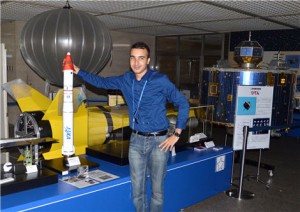
A pair of researchers in Japan has lost their third paper in a UK journal, which cites problematic images and an institutional investigation for the move.
The 2016 article, “Novel Rh-substituted hexaaluminate catalysts for N2O decomposition,” was written by Rachid Amrousse and Akimasa Tsutsumi, of the Japan Aerospace Exploration Agency, or JAXA, in Sagamihara. It appeared in Catalysis Society & Technology, a publication of the Royal Society of Chemistry, and has been cited seven times, according to Clarivate Analytics’ Web of Science.
According to the retraction notice:
The Royal Society of Chemistry hereby wholly retracts this Catalysis Science & Technology article. As part of an investigation carried out by the Japan Aerospace Exploration Agency (JAXA) it was concluded that the data presented in Fig. 1 and Fig. 5 are not reliable, and therefore the article should be retracted. JAXA has informed the Royal Society of Chemistry that both authors agree to retract the paper.
The similarities in the spectra of Fig. 1 from 10–20° (2?) for x = 0; 0.3; 0.5 and 0.8 are due to the inappropriate application of smoothing software (Diffract+) on noisy raw data over a short measurement time (5 min).
The published data in Fig. 5 does not correspond to the relevant results in the original experimental notebook.
The authors, R. Amrousse and A. Tsutsumi, were contacted but did not respond.
Amrousse has two other retractions from CS&T, one in 2013 on a paper with Tsutsumi, and another in 2017, for a variety of sins, including authorship issues and plagiarism. (The 2013 paper has been cited twice; the 2017 article, nine times.)
Journals have also issued corrections on at least five of Amrousse’s papers, from 2012 to 2013, for problematic images. For example, Powder Technology published this lengthy correction for the 2013 article “Deposition of mesoporous activated powder alumina on SiC ceramic foam substrates by an in-situ hydrothermal technique:”
The authors confirm that some figures that appeared in the published version are incorrect. The authors apologize for these errors and the corrected version is given bellow:
1) The author list should be corrected.
2) The authors confirm that some figures that appeared in the published version are incorrect.
Fig. 2. XRD patterns of alumina coating layers calcined from 500 to 1200 °C.
The N2 isotherm of the alumina layer should be replaced by the following figure:
“Fig. 3 shows the N2 adsorption/desorption isotherm and pore size distribution of the alumina calcined at 800 °C. In this case, the adsorption isotherm was type IV and the hysteresis loop was close to type H2, characteristic of typical mesoporous materials. The steep increase in N2 volume adsorbed at a relative pressure P/P0 of about 0.4 implies a uniform mesopore size, which is further confirmed by the pore size distribution curve with a large peak at a pore diameter of about 11 nm. The hysteresis loop suggests the existence of some necking in the pore structure. Furthermore, the textural properties show unimodal mesoporous behavior…”.
Fig. 3. N2-adsorption/desorption isotherm of the alumina layers calcined at 800 °C.
The TEM image for the mesoporous alumina coating layer calcined at 800 °C is not correct. The appropriate images were presented as corrigendum:
Fig. 4. TEM image of the mesoporous alumina coating layer calcined at 800 °C.
Fig. 5(b) is incorrect. Therefore, we replaced it by the corrected image as corrigendum:
Fig. 5. SEM micrograph of the alumina layer after ultrasonic cleaning (b).
We can say that the substitution of wrong images by corrected ones has no effect on the final conclusion.
Amrousse made headlines in the Morocco World News in 2013 when he joined JAXA. The news outlet called him:
an ambitious young Moroccan engineer who made his own way, through hard work and professional commitment, to the famous Japanese Aerospace Exploration Agency …
The article added:
Throughout his professional career, Dr. Rachid Amrousse has published numerous scientific researches in major international journals, which are transformed, thanks to their richness, to debate in many conferences on space.
We emailed Amrousse for comment but have yet to hear back.
Hat tip: Rolf Degen
Like Retraction Watch? You can make a tax-deductible contribution to support our growth, follow us on Twitter, like us on Facebook, add us to your RSS reader, sign up for an email every time there’s a new post (look for the “follow” button at the lower right part of your screen), or subscribe to our daily digest. If you find a retraction that’s not in our database, you can let us know here. For comments or feedback, email us at [email protected].
“JAXA has informed the Royal Society of Chemistry that both authors agree to retract the paper.”
This conflicts with “The authors, R. Amrousse and A. Tsutsumi, were contacted but did not respond.”
So, did the authors agree to retract the paper? That agreement must have come in a “response”, right? I’m confused.
Maybe I can clear it up:
1) JAXA told the journal the two authors agreed to the retraction
2) The journal contacted the two authors but got no response
So, they apparently responded to JAXA (being employees there at the time JAXA did their investigation, that makes sense), but not the journal (possibly because they no longer worked there when JAXA communicated with the journal).